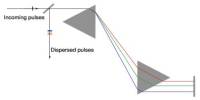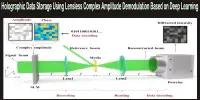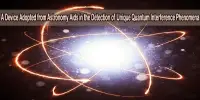The quantum vacuum, also known as the zero-point field, is a concept in quantum physics that describes the lowest possible energy state of a physical system. According to quantum mechanics, even in empty space, there are still fluctuations in the energy levels of the vacuum, which give rise to a range of physical phenomena.
A novel theory for monitoring a quantum vacuum has been devised by researchers, and it may provide fresh information about how black holes behave.
The Unruh effect combines quantum physics and the theory of relativity. So far it has not been possible to measure or observe it, but now new research from a team led by the University of Nottingham has shed light on how this could be achieved using sound particles. The team’s research has been published today in the journal Physical Review Letters.
According to the Unruh effect, when traveling through a quantum vacuum at a high rate of acceleration, the space appears to be filled with particles rather than being a vacuum. This phenomenon is closely related to the Hawking radiation from black holes.
A research team from the University of Nottingham’s Black Hole Laboratory in collaboration with University of British Columbia and Vienna University of Technology has shown that instead of studying the empty space in which particles suddenly become visible when accelerating, you can create a two-dimensional cloud of ultra-cold atoms (Bose-Einstein condensate) in which sound particles, phonons, become audible to an accelerated observer in the silent phonon vacuum. The sound is not created by the detector, rather it is hearing what is there just because of the acceleration (a non-accelerated detector would still hear nothing).
The quantum vacuum is also a crucial aspect of quantum field theory, which is used to describe the behavior of particles at the quantum level. In this framework, particles are viewed as excitations of underlying quantum fields that permeate all of space.
Many laws of quantum physics are universal. They can be shown to occur in very different systems. One can use the same formulas to explain completely different quantum systems. This means that you can often learn something important about a particular quantum system by studying a different quantum system.
Jörg Schmiedmayer
The vacuum is full of particles
One of the basic ideas of Albert Einstein’s theory of relativity is: Measurement results can depend on the state of motion of the observer. How fast does a clock tick? How long is an object? What is the wavelength of a ray of light?
There isn’t a concrete solution to this; it all relies on how quickly the observer is traveling. But what about the question of whether a certain area of space is empty or not? Shouldn’t two observers at least agree on that?
No, because what to one observer appears to be a perfect vacuum to another could be a tumultuous swarm of particles and radiation. According to William Unruh’s 1976 discovery of the Unruh effect, the vacuum has a temperature for substantially accelerated observers. This is caused by so-called virtual particles, which are also in charge of other significant outcomes, such as the evaporation of black holes caused by Hawking radiation.
“To observe the Unruh effect directly, as William Unruh described it, is completely impossible for us today,” explains Dr. Sebastian Erne who came from the University of Nottingham to the Atomic Institute of the Vienna University of Technology as an ESQ Fellow a few months ago. “You would need a measuring device accelerated to almost the speed of light within a microsecond to see even a tiny Unruh-effect -we can’t do that.”
However, there is another way to learn about this strange effect: using so-called quantum simulators.
Quantum simulators
“Many laws of quantum physics are universal. They can be shown to occur in very different systems. One can use the same formulas to explain completely different quantum systems,” says Jörg Schmiedmayer from the Vienna University of Technology. “This means that you can often learn something important about a particular quantum system by studying a different quantum system.”
“Simulating one system with another has been especially useful for understanding black holes, since real black holes are effectively inaccessible,” Dr. Cisco Gooding from the Black Hole laboratory emphasizes. “In contrast, analogue black holes can be readily produced right here in the lab.”
This is also true for the Unruh effect: Another quantum system can be established and studied in order to see the effect there if the original version cannot be proved for practical reasons.
Atomic clouds and laser beams
Similar to how a particle causes “disturbances” in empty space, the cold Bose-Einstein condensate also experiences minor abnormalities (sound waves) that propagate in waves. Such anomalies should be visible with specialized laser beams, as has now been demonstrated. Despite the interaction with the laser light, special techniques are used to ensure that the Bose-Einstein condensate is only slightly disrupted by the measurement.
Jörg Schmiedmayer explains: “If you move the laser beam, so that the point of illumination moves over the Bose-Einstein condensate, that corresponds to the observer moving through the empty space. If you guide the laser beam in accelerated motion over the atomic cloud, then you should be able to detect disturbances that are not seen in the stationary case just like an accelerated observer in a vacuum would perceive a heat bath that is not there for the stationary observer.”
“Until now, the Unruh effect was an abstract idea,” says Professor Silke Weinfurtner who leads the Black Hole laboratory at the University of Nottingham, “Many had given up hope of experimental verification. The possibility of incorporating a particle detector in a quantum simulation will give us new insights into theoretical models that are otherwise not experimentally accessible.”
Preliminary planning is already underway to carry out a version of the experiment using superfluid helium at the University of Nottingham.
“It is possible, but very time-consuming and there are technical hurdles for us to overcome,” explains Jörg Schmiedmayer. “But it would be a wonderful way to learn about an important effect that was previously thought to be practically unobservable.”
















